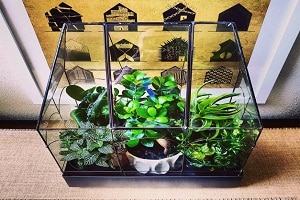If you’ve thought about bringing some lush greenery indoors or setting up your own terrarium planter, you’ve probably seen and heard all about how you don’t need to water them often (hardly at all, really) after you plant.

But how can this be when you have to water so many other plants daily, or even more frequently? Let’s take a closer look.
So What Happens to the Water in a Plant Terrarium?
First, it’s not all terrariums that you don’t need to water – just the closed ones that have a glass case that fits snugly over the tray at the top.
The thing is that these terrariums are able to recycle the moisture you put in them over and over again for many weeks – even longer.
Here’s how it works. Plants absorb moisture through their roots, which they then use in a wide variety of cellular processes. Ultimately, the plants use this water for two functions – to produce sugars using photosynthesis as well as for cooling.
As the plant rearranges nutrients in its cells, it releases some water as a byproduct through little holes under its leaves, known as stomata. This process is known as transpiration, and it results in a net loss of moisture through the plant.
The plant must then reabsorb water through its roots to continue the process, which is the reason we need to water them.
However, in a closed terrarium, when the plants transpire all that water, it has nowhere to go. In the open atmosphere, it would evaporate away, continuing the water cycle – but in a terrarium planter, that moisture in the air is trapped.
When the humidity builds up to a certain point, that water condenses on the glass of the terrarium case and then trickles back down into the dirt, where the plants can reabsorb it, over and over again.
That’s why you don’t need water terrariums frequently, and how they’re able to recycle their water.
Are There Any Types of Terrarium Planters YouDo Need to Water?
Please note, the process described above only refers to closed terrariums, such as Wardian cases, that don’t allow air and water vapor to escape.
If you have one of those types of special succulent terrariums with an opening at the top of one of the sorts that have a small hole in the side, you’ll still need to water it infrequently – as needed by the plants contained within the open terrarium.
What Plants Can Thrive in a Terrarium?
There are plenty of different species that will thrive within a terrarium, including but not limited to:
● Ferns & mosses
● Succulents
● Cacti
● Air plants
● Jade plants
● Orchids
● African violets
● Baby tears
● Zebra plants
● Aluminum plants
● Pothos
● Croton
● Earthstars
● Nerve plants
● False shamrocks
● Venus flytraps
● And more!
This is not a complete list – there are many other types of plants that will thrive in a terrarium as long as they are afforded the proper level of care!
Please be aware that all of the species listed above have their own needs for water intake, and overwatering some can actually be harmful. For example, many succulent plants and cacti are intolerant of overwatering and will develop root rot or die if the substrate is constantly wet.
Where Can You Find High-Quality Terrarium Planters?
One of the best venues for high-quality glass terrarium planters in unique designs is H Potter (hpotter.com). Their collection of terrariums for sale, like their other home decor for the home and garden, features handcrafted pieces of exceptionally high-quality, made from equally high-quality materials.
In addition to terrariums, they also offer hanging planters, trellises, flower pots, and much more. They even provide free shipping on all of their products, so check out their collection of terrariums today!
For more information about Trellis Screen and Tall Planters Please visit: H Potter.
Hi, I am Adam Smith, Admin Of TechSketcher, Creative blogger and Digital Marketer.